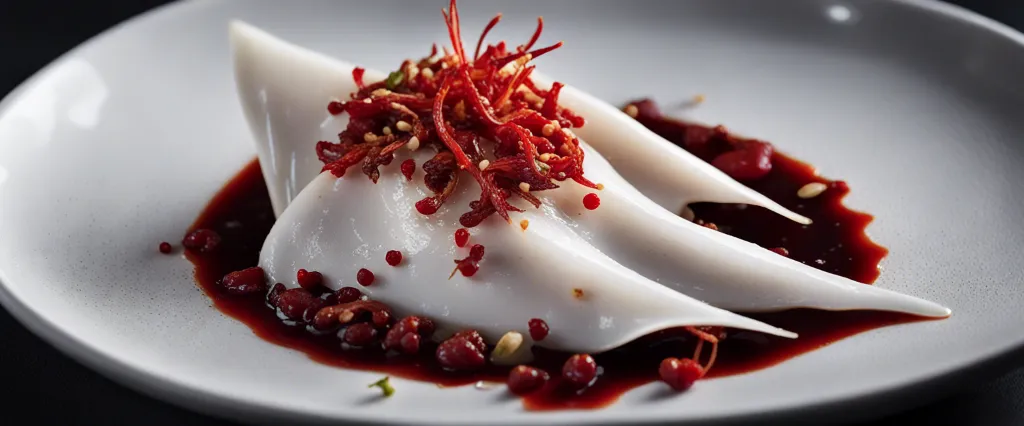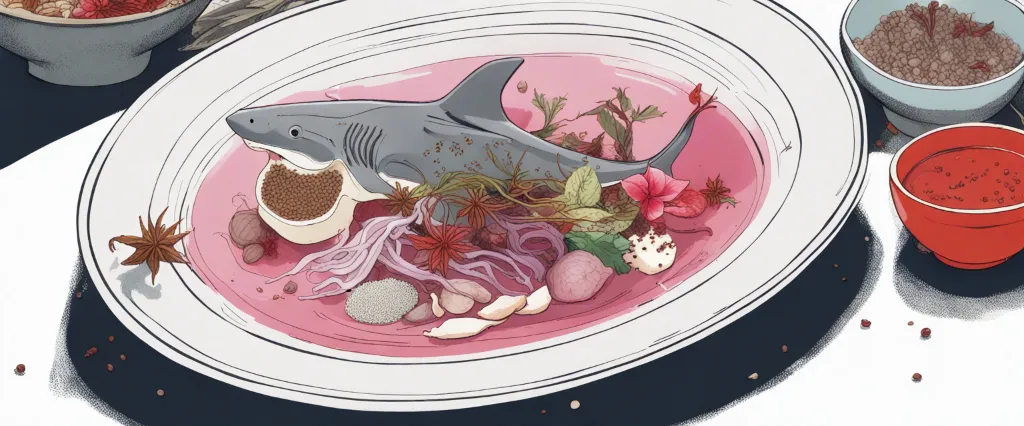Shark’s Fin and Sichuan Pepper by Fuchsia Dunlop is a memoir that takes readers on a captivating culinary journey through the vibrant and flavor-rich world of Chinese cuisine. In this captivating book, Dunlop recounts her experiences as the first Westerner to enroll at the prestigious Sichuan Institute of Higher Cuisine in Chengdu, China. As she delves into the intricacies of Sichuanese cooking, she not only discovers the secrets behind iconic dishes but also unravels the cultural and historical significance of Chinese gastronomy. Fuchsia Dunlop, an English food writer and chef, has become a prominent authority on Chinese cuisine. Having studied and lived in China for several years, Dunlop offers a unique perspective that intertwines her personal adventures with a deep understanding and appreciation for the rich culinary heritage of China. Her passion for Chinese food and her ability to weave captivating stories make Shark’s Fin and Sichuan Pepper a delicious and enlightening read for anyone intrigued by the world of cooking and culture.
Chapter 1: The Culinary Adventure Begins
In Chapter 1 of “Shark’s Fin and Sichuan Pepper” by Fuchsia Dunlop, the author sets off on a culinary adventure in China. She begins by describing her fascination with Chinese cuisine and her decision to move to Chengdu, the capital of Sichuan province, to study cooking at the Sichuan Institute of Higher Cuisine.
Upon arriving in Chengdu, Fuchsia is captivated by the vibrant food markets and the array of ingredients on offer. She explores traditional Sichuan dishes such as Mapo Tofu and Kung Pao Chicken, and her taste buds are awakened to the bold and intense flavors that Sichuan cuisine is renowned for. She also experiences the unique numbing sensation brought on by the Sichuan peppercorn, which gives the cuisine its distinctive character.
Fuchsia delves into the history and culture behind Sichuan cuisine, discovering the importance of Chengdu as the gateway to the ancient Silk Road, a trading route that brought foreign influences and ingredients to the region. She immerses herself in the local food scene, frequents small local restaurants, and forms friendships with fellow food enthusiasts who introduce her to the hidden gems of Sichuanese cooking.
Throughout the chapter, Fuchsia expresses her love and appreciation for the abundance and variety of Chinese food. She is fascinated by the wide range of flavors, from spicy and numbing to tangy and sweet, and is determined to learn as much as she can about Sichuan cuisine. With this appetite for knowledge, Fuchsia embarks on her culinary adventure, eager to explore the rich traditions and complexities that Chinese cuisine has to offer.
Chapter 2: Exploring Sichuan’s Flavors
Chapter 2 of the book “Shark’s Fin and Sichuan Pepper” by Fuchsia Dunlop delves into the unique and diverse flavors of Sichuan cuisine. The author starts by highlighting the geography of Sichuan, a region in southwestern China known for its varied topography and fertile lands, which offer abundant ingredients for its culinary delights.
Dunlop explores the key elements that define Sichuan cuisine, including the transformative power of spices, particularly Sichuan pepper, which imparts a distinctive numbing and tingling sensation. She explains the ancient origins of Sichuan pepper and its significance in enhancing the flavors of local dishes.
The chapter further investigates the different flavor profiles prominent in Sichuan cooking. Among these, the author emphasizes the concept of “ma la,” a combination of numbing (ma) and spicy (la) sensations derived from Sichuan pepper and chili peppers. This unique taste is crucial to many of the region’s signature dishes.
Dunlop also highlights the importance of fermented ingredients, such as doubanjiang (spicy bean paste) and Pixian douban (broad bean paste), which lend a complex umami flavor to Sichuan dishes. Additionally, she discusses the liberal use of garlic, ginger, and scallions to add depth and fragrance.
The author delves into the different cooking techniques used in Sichuan cuisine, including stir-frying, dry-frying, braising, and the iconic Sichuan hot pot. Each technique contributes to the array of textures and flavors found in traditional dishes.
Through this chapter, Dunlop provides a comprehensive overview of the distinctive flavors and culinary traditions that have made Sichuan cuisine internationally renowned. The exploration of Sichuan’s diverse flavors sets the stage for the subsequent chapters, where the author delves deeper into specific dishes and the vibrant culture surrounding Sichuan cuisine.
Chapter 3: A Journey Through Sichuan’s Gastronomic History
Chapter 3: A Journey Through Sichuan’s Gastronomic History of the book “Shark’s Fin and Sichuan Pepper” by Fuchsia Dunlop explores the rich culinary heritage of Sichuan province in China.
The chapter begins with Dunlop’s arrival in Chengdu, the capital city of Sichuan, where she immerses herself in the region’s gastronomic past. She visits a teahouse known for its ancient traditions, witnessing the elaborate tea pouring ceremonies that have been passed down through generations. This experience emphasizes the significance of tea in Sichuan’s culinary culture.
Continuing her gastronomic journey, Dunlop delves into the importance of preserving historical recipes, documenting encounters with elderly Sichuanese chefs who still possess traditional cooking skills. These chefs represent a link to the past, creating dishes that are deeply rooted in the region’s history. She learns about the art of stir-frying and the intricacies of Sichuanese flavors, such as the balance between “Mala,” the numbing and spicy taste from Sichuan pepper, and “Ku,” the mouthwatering sensation of umami found in various ingredients.
Dunlop also explores the profound impact of regional geography on Sichuanese cuisine. The province’s diverse landscapes, ranging from mountains to fertile plains, have influenced the availability of ingredients and cooking methods. For instance, she discovers the use of wild herbs and flowers in Sichuanese dishes, showcasing the abundance of natural resources and the ingenious ways locals utilize them.
Throughout the chapter, Dunlop highlights the cultural and historical significance of Sichuanese cuisine in China. She portrays the culinary heritage as a way for the local people to connect with their past and preserve their identity. By exploring Chengdu’s culinary treasures, Dunlop presents readers with a fascinating glimpse into Sichuan’s rich gastronomic history.
Chapter 4: The Art of Noodle Making

In Chapter 4 of Shark’s Fin and Sichuan Pepper by Fuchsia Dunlop, titled “The Art of Noodle Making,” the author delves into the fascinating world of Chinese noodle culture and the artistry involved in creating these beloved staple dishes.
Dunlop begins by introducing us to the culinary heritage of Noodles in China, emphasizing their significance as a quintessential comfort food. She invites us on a journey to Shanxi Province, known for its rich history in noodle creation. There, she explores the traditional noodle-making methods that have been passed down for generations. From hand-pulled to knife-cut noodles, Dunlop explains the diverse techniques and regions where these different styles are prevalent.
The author further delves into the importance of the “liangfen” noodles in the province of Yunnan, describing them as a cold dish made from bean starch. Dunlop elaborates on the intricate texture and the precision required to balance the flavors. She emphasizes the role of freshness and showcases the dedication of the chefs who diligently produce these noodles in small stalls, ensuring that every strand is perfect.
Throughout the chapter, Dunlop highlights the craftsmanship and symbolism behind these noodle-making techniques. From the significance of long-life noodles to the skill required in pulling or cutting them, every step is executed with care and precision. She also explores the different ways noodles are consumed, such as in soups, stir-fries, or served cold, and how they vary by region.
Ultimately, Chapter 4 of Shark’s Fin and Sichuan Pepper offers readers a deeper appreciation for the artistry, history, and cultural importance of Chinese noodle-making. Dunlop’s vivid descriptions and insightful anecdotes provide a captivating glimpse into the complex and cherished world of noodles in China.
Chapter 5: The Thrill of Street Food
Chapter 5 of “Shark’s Fin and Sichuan Pepper” by Fuchsia Dunlop titled “The Thrill of Street Food” delves into the vibrant and diverse street food culture of Chengdu, China. The chapter explores Dunlop’s exploration of various street food vendors, their culinary offerings, and the unique atmosphere surrounding these experiences.
Dunlop first sets the scene with her descriptions of the streets bustling with food stalls and carts up and running in the evenings. She illuminates the excitement and energy surrounding street food, capturing the attention of locals and tourists alike. The author admits to having a love affair with street food and portrays it as a genuine reflection of the city’s food culture.
Dunlop’s journey begins with exploring the world of Chengdu’s dumplings. She visits a family-run stall where the matriarch, Granny Ye, skillfully creates more than twenty different types of dumplings. Through their conversation, Dunlop gains an insight into the history and traditions behind each dish.
The author then moves on to other street food delights, such as “jianbing” (a savory pancake) and “ma la tang” (spicy hot pot). She shares her experiences of trying these dishes while chatting with vendors and getting to know their stories. Dunlop emphasizes the honesty and simplicity of these meals, showcasing the deep connection between food and the people who create it.
Throughout the chapter, Dunlop emphasizes the joy and thrill that comes with indulging in street food. Her encounters with passionate and talented street food vendors and the unique flavors they offer highlight the rich tapestry of Chengdu’s culinary landscape. She emphasizes the importance of appreciating street food as an essential part of the city’s food culture, immersing oneself in the vibrant chaos and embracing the unknown.
Chapter 6: Into the Heart of Sichuan’s Kitchens
Chapter 6: Into the Heart of Sichuan’s Kitchens takes readers deeper into the culinary world of Sichuan province in Fuchsia Dunlop’s book “Shark’s Fin and Sichuan Pepper.” This chapter serves as a window into the cornerstone of Sichuan cuisine – its vibrant and unforgettable flavors.
Dunlop starts by sharing her arrival in Chengdu, the capital of Sichuan province, and her first encounter with the famous street food culture. She describes the bustling alleys filled with food stalls, where locals and visitors alike indulge in various dishes like spicy noodles, ma po tofu, and skewered meats.
The story then transitions to Dunlop’s initiation into a cooking school led by a charismatic and revered teacher, Madame Zhou, who becomes her mentor. Under Madame Zhou’s guidance, Dunlop explores the intricacies of Sichuan cooking techniques and learns about the key ingredients that define the cuisine’s unique flavors. She witnesses the intense and bold use of spice, particularly Sichuan peppercorns, which provide not just heat but also a tingling and numbing sensation.
As Dunlop delves further into the heart of Sichuan’s kitchens, she unveils the painstaking preparation processes behind essential Sichuan dishes. She learns about the delicate art of cutting, where precision slicing and dicing affect the final texture and presentation. From the fiery and numbing hot pots to the lavish banquets, Dunlop meticulously explores the diverse and aromatic flavors that Sichuan cuisine offers.
This chapter is a celebration of Sichuan’s culinary heritage, highlighting the passion and dedication of its chefs. Through her experiences, Dunlop invites readers to appreciate the bold flavors, intricate techniques, and cultural richness that make Sichuan cuisine one of the most revered and beloved around the world.
In summary, Chapter 6 of “Shark’s Fin and Sichuan Pepper” immerses readers in the vibrant street food culture, introduces them to a revered cooking teacher, and explores the unique ingredients and techniques that define Sichuan cuisine. It showcases the artistry and flavors that have made Sichuan cuisine renowned on an international scale.
Chapter 7: From Farm to Table
In Chapter 7: From Farm to Table of the book “Shark’s Fin and Sichuan Pepper” by Fuchsia Dunlop, the author delves into the process of food production and consumption in China, particularly focusing on the Sichuan region.
Dunlop begins by highlighting the profound cultural significance attached to food in China, where it is not just a means of sustenance but also an essential part of socialization and identity. She emphasizes that understanding the source and production methods of food is crucial to fully comprehend the cuisine and its connection to Chinese culture.
The author takes the readers on a journey through the vibrant Sichuan countryside, where she visits local farms and learns about the traditional farming practices employed there. She describes the intricate relationships between farmers and the land, their reliance on irrigation systems, and their commitment to preserving ancient techniques despite modern influences.
Dunlop also explores the challenges faced by farmers due to changes in agricultural policies and industrialization. Large-scale farming and the use of chemical fertilizers threaten traditional farming methods, causing concerns about the impact on food quality and taste.
Moreover, the chapter examines the role of markets and street food in Chinese food culture. The author immerses herself in the bustling Chengdu market, a mecca for food enthusiasts, and experiences the captivating atmosphere of street food stalls. She discusses the importance of freshness and the immediacy of food consumption that defines the Chinese culinary experience.
Overall, Chapter 7 provides an insightful glimpse into the farm-to-table journey in the Sichuan region, highlighting the intimate connection between food, culture, and the land. Dunlop emphasizes the significance of sustainable farming practices, the preservation of traditional techniques, and the essential role of local markets and street food in the Chinese food landscape.

Chapter 8: Beyond Sichuan: Culinary Adventures Across China
Chapter 8: Beyond Sichuan: Culinary Adventures Across China of “Shark’s Fin and Sichuan Pepper” by Fuchsia Dunlop takes readers on a gastronomic journey through various regions of China beyond Sichuan province.
Dunlop starts by exploring the cuisine of Hunan, known for its spicy and sour flavors. She introduces the iconic dish of Chairman Mao’s hometown, red-braised pork belly or “Mao’s Family Dish.” Dunlop delves into the cultural significance of the dish and its connection to Chairman Mao’s life, making it a symbol of Chinese history and revolution.
Moving on, Dunlop ventures to Jiangxi province, where she discovers the unique and ancient tradition of “Xiao Chi” or small eats. These small, flavorful snacks are popular among locals and showcase the region’s diverse culinary offerings. Dunlop tries a range of dishes, including “Fermented Bean Curd Zhaoqing Style” and “Xiao Niu Rou Jia Mo,” a type of beef burger.
Next, Dunlop explores the elaborate culinary traditions of Anhui province. She learns about the importance of huangshan (yellow mountain) and its influence on the region’s cuisine, which focuses on wild mushrooms, bamboo shoots, and freshwater fish. Dunlop describes the memorable dining experience of tasting “Tofu Braised with Tea Leaves” and “Stone-potted Fish.”
The chapter concludes with Dunlop’s visit to Yunnan province, where she encounters the vibrant and diverse flavors of the region. She navigates through local markets and tries dishes like “Crossing Bridge Rice Noodles” and “Yunnan-Style Steamed Pot Chicken.” Dunlop also highlights the region’s minority cultures and how their culinary traditions contribute to the unique food landscape of Yunnan.
In Chapter 8, Dunlop showcases the breadth and depth of China’s culinary heritage beyond Sichuan, emphasizing the diversity and richness of flavors found across the country. Her exploration not only introduces readers to new dishes but also offers insights into the cultural and historical contexts that shape Chinese cuisine as a whole.
After Reading
In conclusion, “Shark’s Fin and Sichuan Pepper” by Fuchsia Dunlop is a captivating memoir that explores the author’s love affair with Chinese cuisine and her journey to become an expert in Sichuanese cooking. Through vivid descriptions and heartfelt anecdotes, Dunlop takes the readers on a culinary adventure through the bustling streets of China, introducing them to a rich variety of flavors and dishes. Her passion and dedication to the art of cooking shine throughout the book, inspiring readers to explore and appreciate the world of Chinese cuisine. “Shark’s Fin and Sichuan Pepper” is not only a captivating memoir but also a delightful gastronomic exploration that will leave readers hungry for more.
1. “The Food of Sichuan” by Fuchsia Dunlop: As a well-known authority on Chinese cuisine, Dunlop provides another insightful exploration into the unique flavors and techniques of Sichuan cooking. This book offers a comprehensive collection of recipes, along with cultural anecdotes and information about key ingredients.
2. “Land of Fish and Rice: Recipes from the Culinary Heart of China” by Fuchsia Dunlop: In her exploration of the lower Yangtze region, Dunlop delves into the rich culinary traditions found in Jiangnan. With beautiful photography and detailed recipes, this book introduces readers to the flavors of Shanghai, Suzhou, and Hangzhou.
3. “Every Grain of Rice: Simple Chinese Home Cooking” by Fuchsia Dunlop: A departure from the study of specific regional cuisines, this book focuses on everyday Chinese home cooking. Packed with easy-to-follow recipes, “Every Grain of Rice” invites readers to explore the diversity and simplicity of Chinese cuisine by making authentic dishes in their own kitchens.
4. “The Gastronomical Me” by M.F.K. Fisher: This memoir takes readers on a culinary journey as Fisher recounts her experiences with food and dining throughout her life. With vivid descriptions and evocative storytelling, Fisher’s reflections on meals and their significance provide an engaging and personal window into the world of gastronomy.
5. A Cook’s Tour: Global Adventures in Extreme Cuisines” by Anthony Bourdain: Known for his adventurous spirit and irreverent writing style, Bourdain chronicles his travels around the world in search of unique and sometimes outrageous culinary experiences. With his wit and candor, this book is an exhilarating read for anyone interested in discovering new and unusual flavors from various cultures.



